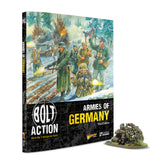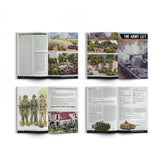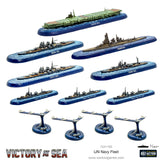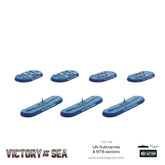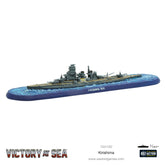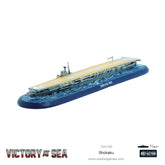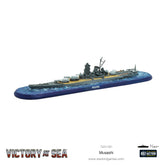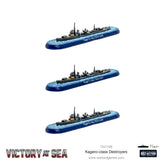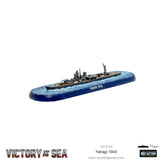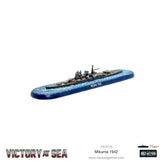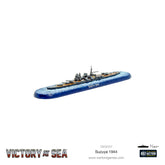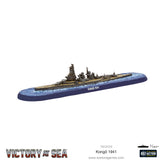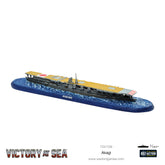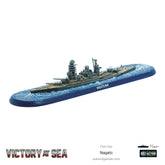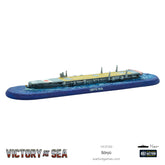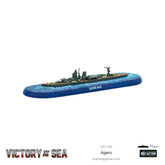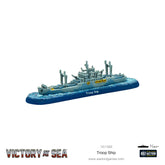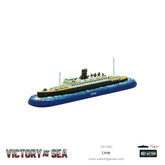Victory at Sea - Imperial Japanese
The Japanese understood the potential of airpower, early on, creating an effective carrier arm. In addition, the Imperial Japanese Navy possessed a powerful battleship force, which included the largest and most powerful battleships in the world, the Yamato and the Musashi.
The Imperial Japanese Navy’s potential was demonstrated in the attack on Pearl Harbor in 1941, devastating the US fleet at anchor. Midway was the turning point of naval war in the Pacific and, thereafter, the Japanese were unable to make headway against the increasing carrier strength of the US Navy. With the victorious Allies pushing towards the Japanese islands, kamikaze aircraft and other suicide weapons were deployed against US forces.
Learn more about the Japanese fleets HERE
- 10
- 15
- 20
- 25
- 30
- 50
- Featured
- Best selling
- Alphabetically, A-Z
- Alphabetically, Z-A
- Price, low to high
- Price, high to low
- Date, old to new
- Date, new to old
Sort by:
- Featured
- Best selling
- Alphabetically, A-Z
- Alphabetically, Z-A
- Price, low to high
- Price, high to low
- Date, old to new
- Date, new to old
-
Victory at Sea IJN fleet[countdown]2020/08/29 0:0:00[/countdown] For centuries, Japan's policy of seclusion (sakoku) saw it concentrate on coastal defences in order to repel foreign vessels. However, with the advances other maritime nations were making, it eventually became obvious that no longer would Japan be able to ignore the...
- £93.50
£110.00- £93.50
- Unit price
- / per
-
Victory at Sea - IJN Submarines & MTB sectionsSubmarines: The Kaidai-7-class, or KD-7, was developed in the late 1930s, following on from the preceding KD-6 class. With a surface range of 8,000nm at 16kts, and a submerged endurance of 50nm at 5kts, they possessed a slightly better underwater performance to the late-model...
- £29.33
£34.50- £29.33
- Unit price
- / per
-
Victory at Sea: KirishimaThe Kongō-class, dating from 1912, was rebuilt between 1927 and 1931 and was thereafter re-rated as a battleship. Armed with eight 14-inch guns in dual turrets and a secondary battery of sixteen 6-inch guns, the Kongō was further rebuilt in the late 1930s. Hiei...
- £17.43
£20.50- £17.43
- Unit price
- / per
-
Victory at Sea – ShōkakuThe two ships of the Shōkaku-class (Shōkaku and Zuikaku) were used with extreme effectiveness in many engagements within the Pacific theatre. Starting at Pearl Harbor, the role of honour includes sinking the British carrier HMS Hermes and aiding in the destruction of the USS Lexington and USS Hornet,...
- £20.83
£24.50- £20.83
- Unit price
- / per
-
Victory at Sea – MusashiBy a large margin, the Yamato and Musashi were the largest battleships ever built and were the product of advancing Japanese technology. They were twice the displacement of most Allied battleships and their 18.1-inch guns could outrange anything in the Allied arsenal. It was the hope of the...
- £17.43
£20.50- £17.43
- Unit price
- / per
-
Victory at Sea - Kagero-class DestroyersEssentially an enlarged Fubuki-class, the Kagerō-class hull design was scaled up to overcome earlier design deficiencies. As a result, the Kagerō-class was the equal of any of its contemporaries in other navies and superior to most. Only the initial lack of radar and continued...
- £23.38
£27.50- £23.38
- Unit price
- / per
-
Victory at Sea - YahagiYahagi was the third of the Agano class of light cruiser, intended to be the flagship of a destroyer flotilla. She was completed in December 1943. She participated in the Battles of the Philippine and Leyte Gulf and remained relatively unscathed despite weathering repeated...
- £14.03
£16.50- £14.03
- Unit price
- / per
-
Victory at Sea - MikumaThe second of the four Mogami class heavy cruisers, Mikuma was completed in 1935 but quickly underwent refits to replace her main turrets with twin 203 mm guns. Her former weapons, triple 155mm guns went to Yamato. Early in her career she was tasked...
- £14.03
£16.50- £14.03
- Unit price
- / per
-
Victory at Sea - SuzuyaThe heavy cruiser, Suzuya, is believed to be one of the deepest shipwrecks on record at (a yet) unconfirmed 27,600 feet. She met her fate at the Battle of Leyte Gulf when she was beset upon by carrier-based aircraft – a torpedo exploding in...
- £14.03
£16.50- £14.03
- Unit price
- / per
-
Victory at Sea - ZuikakuZuikaku ( 瑞鶴 “Auspicious Crane”), a Shōkaku-class aircraft carrier, along with her sister ship, were the most successful carriers operated by the Japanese Navy during WW2. The Japanese had learnt many lessons prior to her construction and as such Zuikaku was considerably larger, better...
- £20.83
£24.50- £20.83
- Unit price
- / per
-
Victory at Sea - KongoKongō (金剛, “Indestructible Diamond”), named for the mountain, was the first battleship of her class, serving in both the first and second world wars. At the time of construction in the early 1910s she was a capital ship (the last Japanese Capital ship to...
- £17.43
£20.50- £17.43
- Unit price
- / per
-
Victory at Sea - AkagiOriginally laid down as an Amagi-class battlecruiser, the stipulations of the Washington Treaty resulted in her conversion to an aircraft carrier. As a result, Akagi (赤城, "Red Castle") was one of Japan’s first large aircraft carriers. Akagi and her near-sister Kaga straddled the line...
- £20.83
£24.50- £20.83
- Unit price
- / per
-
Victory at Sea - NagatoThe flagship of the Japanese fleet during the attack on Pearl Harbor, the i was also the first battleship in the world to mount 16-inch guns. The Nagato continued to serve throughout the war, eventually returning to Japan as the US forces approached. With...
- £17.43
£20.50- £17.43
- Unit price
- / per
-
Victory at Sea - SoryuAs the lead ship of her class of fleet carriers, the Sōryū was built around a sleek cruiser-style hull and powerful engines, enabling her to outrun the carrier Kaga at only about 40% power. In fact, at the time of her launch, Sōryū was...
- £20.83
£24.50- £20.83
- Unit price
- / per
-
Victory at Sea - AganoThe Agano-class was designed as a swift and lightly armoured replacement for the aging Tenryu, Kuma and Nagara classes. They were predominantly used as destroyer and cruiser leaders. The lead ship in the class, the Agano, saw action in the Battle of Empress Augusta...
- £14.03
£16.50- £14.03
- Unit price
- / per
-
Victory at Sea - Troop ShipWhile the big liners represented the glamorous end of conveying armies around the globe (if such a word can be applied to those duties) smaller cargo liners performed as valuable a role carrying both troops and supplies. Contains one resin & metal vessel, with...
- £11.90
£14.00- £11.90
- Unit price
- / per
-
Victory at Sea - LinerDuring the 1920s and 1930s, liners plied the seaways as the ultimate symbol of travel luxury. After September 1939, many were requisitioned and served as fast troop transports, carrying thousands of troops across the globe. Contains one resin & metal vessel, with game aids....
- £11.90
£14.00- £11.90
- Unit price
- / per






